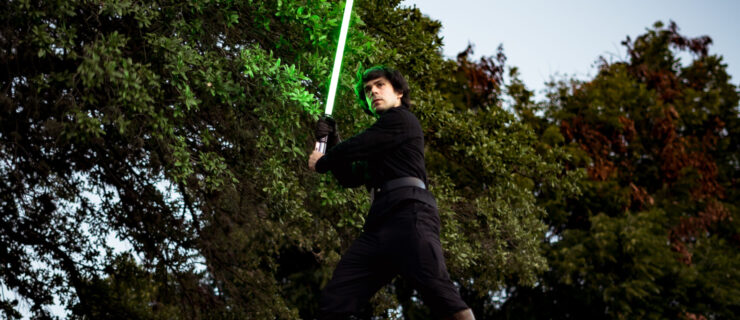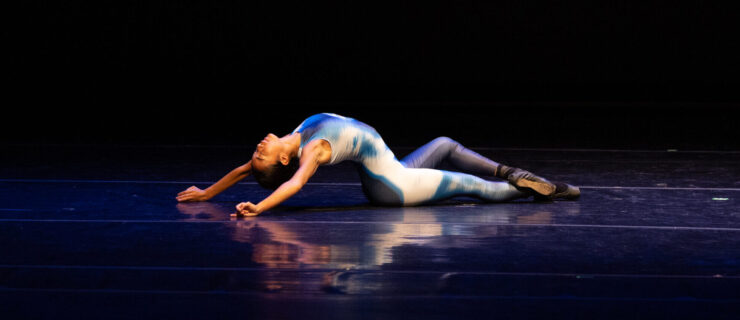Get to Know 18-Year Old Maria Khoreva, the Mariinsky Ballet's Rising Star
Before Maria Khoreva danced her first performance as a member of the Mariinsky Ballet, she was already a superstar, with devoted Instagram fans following her life as a pupil in the Vaganova Academy (follow her @marachok). Her talent was already obvious—as were her exceptionally long lines, elegant technique and charisma—and when she joined the company’s corps de ballet last summer, it was apparent that her artistry was also far beyond her 18 years.
Khoreva didn’t last long in the corps: in November artistic director Yuri Fateev promoted her to first soloist, the Mariinsky’s second-highest rank. Not even one year into Khoreva’s professional career, her repertoire already includes the title role in Paquita, the lead in Balanchine’s “Diamonds” and Terpsichore in his Apollo, plus Medora in Le Corsaire, which she is performing this week during the Mariinsky’s annual tour to the Kennedy Center. Between performances in Washington, D.C., we spoke to Khoreva via Skype about her life in ballet, overcoming injuries and keeping in touch with 300,000 friends on Instagram.
You’ve had two major debuts in the U.S.—last November in the
Balanchine: The City Center Years festival in New York City, and now in Le Corsaire at the Kennedy Center. What do you think of American audiences?
Just amazing. To see people enjoying ballet here, and to see people enjoying Russian ballet—it’s uplifting and really satisfying. For me ballet is everything, it’s my life, my profession. It’s quite rare to see people loving it so much. For me it’s very special.
You’re 18, and you’re already dancing Medora, Paquita, the lead in “Diamonds,” Terpsichore—giant roles with a big responsibility onstage. Do you feel like you have the freedom to make mistakes and grow into them, or do you feel pressure to be perfect?
I think I have freedom. Dancing, on the whole, is about the experience. You cannot be perfect right away. The growth in ballet is all about trying different ways, and only by trying and experiencing them, and dancing and going onstage, can you find your way to grow. And I have amazing coaches, I have an amazing director, an amazing teacher that I am working with, and amazing partners.
And that would be true for any dancer, at any age.
Yeah. And in terms of pressure, I wouldn’t call it pressure. To be dancing at the Mariinsky Ballet is such a great honor…it’s more a pressure on the inside. When I am dancing for the Mariinsky, I feel that I have to be responsible for that, and I have to represent the company to the audience.
How do you get that confidence at such an early stage of your career?
When I was still a student at Vaganova, there was pressure to be feeling confident onstage, because it was the thing that mattered at the Academy. The more confident you look, the greater the impression that you will make on the audience and on your teachers. I think I’m making myself look confident rather than feeling confident, because before going onstage I’m terrified and really, really nervous. But the second I step onstage, I submerge myself in the atmosphere of the performance. You’re inside of the story, and you feel a part of the ballet, to be a character. That’s what carries me.
At the Vaganova Academy you were in the class of Lyudmila Kovaleva, who taught
Diana Vishneva and Olga Smirnova. How did she help mold you as an artist?
She’s one of the most important people in my life. She taught me how to dance. She taught us how to make our dancing powerful and not just movements, but really bring the energy and the soul into them. It was about using your physical abilities to show your emotional state. I’m eternally grateful for that.

Khoreva in Le Corsaire.
Natasha Razina, Courtesy Kennedy Center.
During your schooling you were sidelined for six months by an Achilles injury. How did you cope with that?
I had the greatest support from my family; I can’t emphasize how grateful and lucky I am for that. During the injury I did a lot of useful things. I tried to learn a bit more English; my mom helped me because she is an English teacher by profession. Also, I learned how to touch-type. We were baking a lot and cooking, and reading quite a lot of literature. And I was thinking about how to improve, too. Sometimes it’s very good to step back and think about how you dance. Not to always dance, dance, dance, but to step back and look at the process. I also did a lot of fitness workouts, like abs and some Pilates. When I got back from that injury, my teacher said, “Masha, you look different. It’s made you better in certain aspects.” I guess I just took my time thinking about what was wrong and what to do after I finally came back. Nevertheless, coping with the injury and not being able to dance was one of the hardest times of my life.
You perform often with
Xander Parish, and you seem to have a special partnership with him.
We started working together when I was still at the Vaganova Academy. Yuri Fateev, our director, invited me to start rehearsing Terpsichore from Apollo with the company. I started working alone, with Yuri. And then one rehearsal, I remember thinking, “Who will be my Apollo?” I go into the studio and Xander is there. I was completely astonished—I was like, “What? Really? Xander Parish? How is that possible?” He was so supportive and kind, and so open to me, that it really helped me with the rehearsal process. To explore the choreography together was pretty much priceless. What’s special about Xander is his kindness, and that he really takes care. He always helps me with making decisions and dealing with people in the company. And dancing with him onstage, I really felt like he would not let me down. Onstage you can really feel when your partner is more thinking about himself than about you. And with Xander, I always feel like he is valuing me more than his dancing, and that he would do everything to make me feel beautiful.

Khoreva and Xander Parish rehearse Apollo during the Balanchine: The City Center Years festival in New York City last October.
Kyle Froman
What are the best and worst aspects of being a social-media star?
There are no bad aspects at all. I just love sharing with people. My audience is the kindest and the most amazing audience ever. They give me so much energy and so much motivation, it’s the loveliest thing. It’s such a captivating process in a way. By using social media, you can talk to people in all the different countries around the world. I just cannot believe this opportunity.
You were promoted from the corps to first soloist so quickly, and the next step is to become a principal dancer. In your mind, how do you need to grow in order to take that next step?
I’m not sure I’ve thought about that. The goals are very simple: to make a role that I’m preparing and dancing, to make it better and better every time. It’s not about the rank in the future. It’s about how you dance and how you execute the role, and your attitude to dancing. That’s what I try to develop in myself—the right attitude. To know why am I dancing and how am I dancing, and what I have to do to make it more beautiful or more dramatic or more clean, technique-wise. Every role needs to be polished like that.






